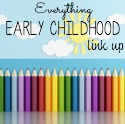As a teacher or parent you know how overwhelming it can be to wade through all the available resources on any particular topic. Today I'm going to make it a little easier for those of you who are looking to teach or enrich a preschooler's days with science activities.
The five resources I will outline in
this post are my most dog-eared and cherished preschool science books
from almost a decade of developing and teaching science for children
ages 3-5. As I pulled them off the shelf to review for this post I
find all sorts of post-it notes sticking out of the edges denoting
certain topics I wanted to quickly find. I would highly recommend
including these in your school, home or homeschool library!
This post contains affiliate links,
please see disclosures for details.

My top pick for a guide to teaching preschool science is Science is Simple: Over 250 Activities for Preschoolers by Peggy Ashbrook. This book is indispensable. It not only includes activities that are easy to complete and are age appropriate but also gives discussion questions, book, poem and song suggestions, ideas for extension activities and reproducible letters to send home explaining the activities completed at school. Peggy Ashbrook is an expert in this field with many years of teaching experience and involvement with the National Science Teacher's Association (NSTA) and the National Association for the Education of Young Children. She is a contributor to NSTA's Early Years blog and writes the Early Years column for the NSTA publication Science and Children. I often seek out her writing to find new ideas and perspective on teaching young children.

Science Play by Jill Frankel Hauser is a fun book with all sorts of playful activities and things to make to explore science concepts. The most well-loved section of my copy is "Air, Air Everywhere" filled with paper air toys to make and activities to do with a drinking straw and your own breath. The section "Sun, Wind, and Rain" is great for studying weather and shadows.

Years ago I was on the search for science activities to get the little ones moving when I stumbled upon Jump into Science: Active Learning for Preschool Children by Rae Pica I love that this book is filled with movement activities that easily tie into any science concept I'd like to teach. A bonus with this one is that there are excellent suggestions for picture books and children's songs that can be used to extend your lesson. I've used many of the role-play and imagination movement activities in this book to help children act out natural processes like a seed developing into a plant and bears getting ready for their long winter's nap.

If there is one resource that I have used throughout my entire teaching career whether it has been in informal environmental education or developing a curriculum map for the traditional science classroom it is the book: Hands On Nature: Information and Activities for Exploring the Environment with Children edited by Jenepher Lingelbach and Lisa Purcell, contributor: Susan Sawyer. With tons of background information on natural history and activities that can be adapted for all ages, it works wherever I am teaching. I love that there are ideas for outdoor activities and creative indoor projects like scripts for puppet shows. Some of my favorites are using the insect transformation game as an active way to teach about metamorphosis, and Animals in Winter Bingo, which uses clues rather than just calling out an animals name.

Lastly, another great resource for preschool and elementary science is A Year of Hands On Science: 100+Standards-Based Activities, Projects and Experiments by Lynne Kepler. This resource follows seasonal changes throughout the year and science activities that accompany these changes. Organized by month, there are 2 themes that each chapter focuses on. Themes are well developed through activities, read-alouds, reproducible letters to send home, and ideas for picture books that accompany lessons. Although this is geared for K-3, there are many ways you can adapt activities for younger ages.
You can intertwine science into your
preschool day with picture books too! Many picture books, whether
they are written with science in mind or not, can help develop
science skills. Any stories where students can be asked to anticipate
what will happen next helps them to develop their inference and
hypotheses development skills. Stories where characters ask questions
and search to find the answer inspire questioning and curiosity.
For example, you can use a book such as
Nancy E. Shaw's Sheep in a Jeep to build
anticipation and prediction skills. It also makes a nice introduction
to a lesson on rolling and sliding! Use a fun story like Helen
Lester's A Porcupine Named Fluffy to talk
about adaptations and differences in animals. The possibilities are
endless!
What are some of your favorite
resources for teaching preschool science? Comment below or e-mail us
at shareitscience@gmail.com
Here is another great preschool STEM activity to try.
Here is another great preschool STEM activity to try.




Thanks for sharing Jump into Science, Sarah!
ReplyDeleteMy pleasure! What a treat to have you stop by my post. Your book definitely has been useful to me throughout the years, especially with the 3 year olds I taught science to for 7 years. Thanks to you! I hope that others will see this and find your book helpful. :)
DeleteSarah, thanks for your recommendations for these terrific E.C. science books!
ReplyDeleteHappy to Lynn! If you ever want to take a peek at any of these I made sure PCS had copies! Thanks for reading. :)
DeleteAsia Citro's "The Curious Kid's Science Book" does a great job of laying out experiments the kids can do themselves.
ReplyDeleteYes! I know of it, but haven't actually used it with kids. Definitely one to check out!
Delete